
Green Chemistry & Environmental Impact Analysis
by Jasmine Coleman
Students will unravel the intricacies of environmental impact analysis, gaining insight into its pivotal role in evaluating the sustainability of chemical processes. Through a blend of explanation, application, and interpretation, learners will navigate the stages of life cycle assessment (LCA) and decipher key indicators used to gauge environmental impact.
In small group settings, students will collaborate to collect data, perform LCA calculations, and craft compelling presentations showcasing their findings. Alongside technical proficiency, emphasis is placed on effective communication skills, both orally and in writing, enabling students to articulate key insights derived from their LCA analyses.
Furthermore, ethical and social considerations are woven throughout the lesson, prompting students to reflect on the broader implications of unsustainable chemical processes and explore innovative solutions to address these challenges. Throughout the lesson, students gain a deeper understanding of green chemistry principles and the tools necessary to champion sustainability in chemical endeavors.
Lesson Plan Link/URL
https://docs.google.com/presentation/d/1d_09eVVG_-IcOhnfdrHEKYm2KgDxv_RYi8bey6G…Subject Area
Science Physical Science P1: Matter Life Science L2: Organisms & Energy Engineering S4: Apply Science to Engineering English Language Arts (ELA) Writing Speaking & Listening
Featured
Off
Related Content

Grades:
9th Grade, 10th Grade, 11th Grade, 12th Grade
A high school physics lesson plan asking students to use guided inquiry and discover how current moves through series and parallel circuits. Students then share their results by using technology to

Grades:
9th Grade, 10th Grade, 11th Grade, 12th Grade
This set of lessons allows students to understand circuitry through different lenses and apply this to simple circuits and electrical calculations.

Grades:
8th Grade, 9th Grade, 10th Grade, 11th Grade, 12th Grade
A lesson that dives into the fusion of Art and Chemistry. Students will make their own pigments using common plants by using an acid-base reaction. They will test the effects of different solvents in